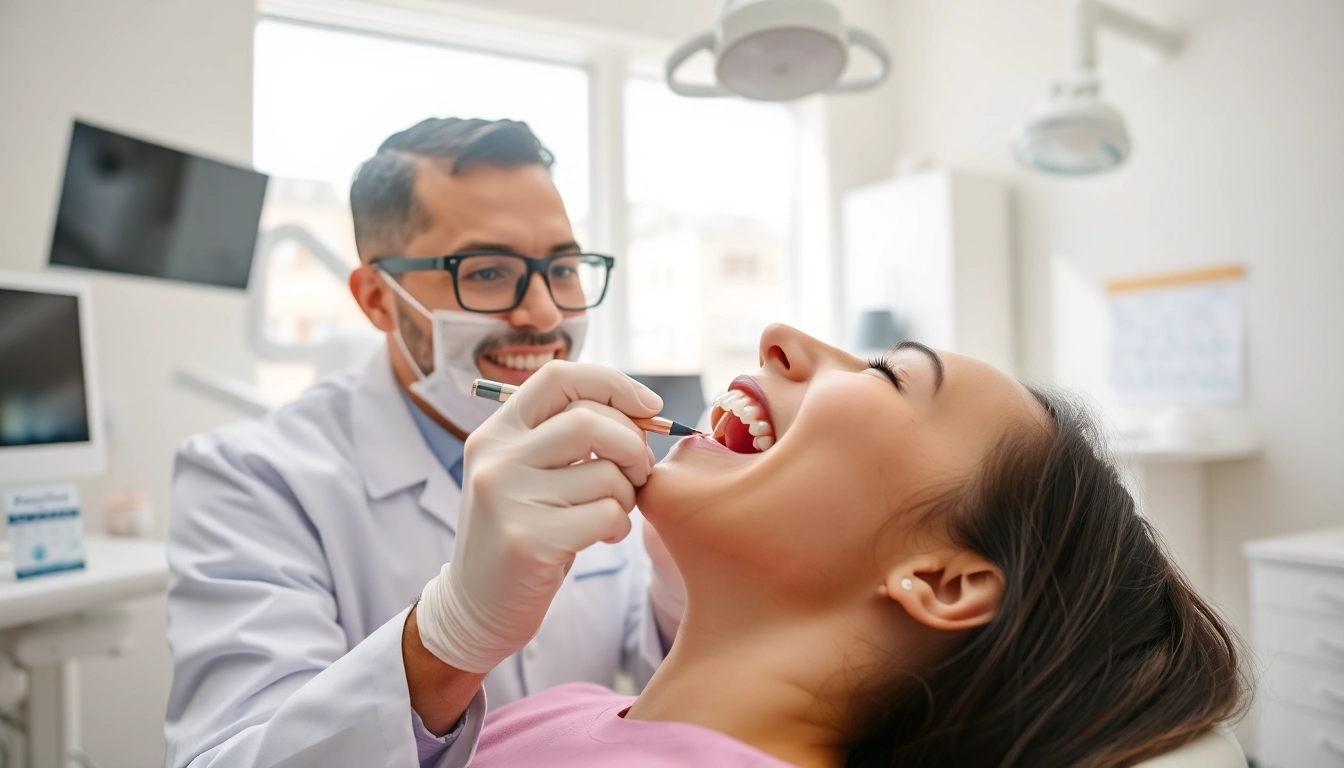Understanding Orthodontic Treatments
Orthodontic treatments play a crucial role in achieving a straight and healthy smile. Whether you’re considering braces for yourself or your child, understanding the options available is essential. Typically, orthodontics involves the diagnosis, prevention, and correction of misaligned teeth and jaws. Within this field, there are various treatment modalities, each tailored to meet individual needs. For residents of Myrtle Beach searching for a reliable treatment provider, finding the right orthodontist Myrtle Beach is crucial for a successful outcome.
Types of Orthodontic Appliances
Orthodontic appliances are designed to gently reposition teeth and jaws over time. The most common types include:
- Metal Braces: The traditional option, metal braces consist of brackets and wires that apply constant pressure to the teeth.
- Ceramic Braces: Similar to metal braces but made from tooth-colored materials, ceramic braces are less noticeable.
- Lingual Braces: Positioned on the back side of the teeth, these braces are virtually invisible from the front.
- Invisalign: A popular clear aligner system, Invisalign uses a series of custom-made, removable aligners to achieve straighter teeth without the need for metal brackets.
Each type of appliance has unique benefits and considerations, making it important to discuss your options with an orthodontist to determine the best fit for your lifestyle and dental needs.
Benefits of Early Evaluation
Early evaluation for orthodontic treatment is recommended for children around the age of 7. During this time, an orthodontist can identify potential issues with tooth alignment and jaw growth. Early intervention allows for more effective treatment options, which can sometimes reduce the need for future extensive procedures. Some benefits of early evaluation include:
- Proactive management of dental growth and development.
- A greater chance for a shorter treatment duration.
- Enhanced self-esteem and confidence from an improved smile at an early age.
Taking the step to schedule an evaluation can set the foundation for a healthy, beautiful smile.
What Age is Ideal for Treatment
While orthodontic treatment can begin at various ages, the ideal timing often depends on the individual and their specific dental situation. The American Association of Orthodontists suggests that children should have their first orthodontic evaluation no later than age 7. This is because by this age, the first permanent molars and incisors have typically erupted. Here are some age-specific guidelines:
- Early Treatment (Ages 7-10): For issues like crossbites or severe crowding, early intervention may be beneficial.
- Pre-Adolescence (Ages 11-14): Most children begin alignment treatments around this time, as their permanent teeth are more established.
- Adolescence and Adulthood: Many adults seek orthodontic care, and thanks to modern options like Invisalign, age is less of a barrier than it once was.
The key is to consult an orthodontist to assess personal needs and determine the best timing for treatment.
Choosing an Orthodontist Myrtle Beach
Finding the right orthodontist is a pivotal step in your orthodontic journey. It’s important to consider several factors, ensuring that the selected professional can deliver effective and comfortable care.
Factors to Consider
When choosing an orthodontist in Myrtle Beach, consider the following:
- Qualifications and Experience: Review the orthodontist’s educational background, certifications, and years of practice.
- Treatment Options: Ensure the orthodontist offers a range of treatments that fit your needs, whether you prefer traditional braces or modern solutions like Invisalign.
- Office Environment: The office should be welcoming and staff should be friendly. A comfortable environment helps to ease any anxieties associated with treatment.
- Technology: Modern technology is crucial in providing effective treatment. Look for offices equipped with up-to-date imaging and treatment planning software.
Taking the time to research and choose the right orthodontist can significantly impact your treatment experience and results.
Reading Online Reviews
Online reviews can provide valuable insights into an orthodontist’s practice. Look for reviews on various platforms, such as Google, Yelp, and Facebook. Here are some tips for navigating online reviews:
- Look for Patterns: Read multiple reviews to identify trends concerning the quality of care, wait times, and staff professionalism.
- Consider the Source: Be cautious of overly emotional or poorly worded reviews. Focus on those that offer detailed accounts of the treatment experience.
- Ask for Recommendations: Personal recommendations from friends, family, or your general dentist can also supplement online research.
Remember that while reviews are helpful, they should be considered as part of a broader decision-making process.
Importance of Initial Consultations
Most orthodontists offer complimentary consultations, which should be taken advantage of. This initial visit is pivotal for several reasons:
- Assessment: The orthodontist will evaluate your dental situation and suggest potential treatment plans tailored to your needs.
- Discussion: It’s an opportunity for you to ask questions, express concerns, and understand what to expect during the treatment process.
- Financial Information: You can discuss costs and payment options, as most offices will provide details about insurance coverage and financing plans.
Taking the time to attend an initial consultation can provide clarity and peace of mind as you embark on your orthodontic journey.
Aligning Your Expectations
Effective communication with your orthodontist regarding your expectations is crucial for a satisfactory treatment experience. Here are aspects to align before beginning any treatment.
Discussing Treatment Plans
After your consultation, your orthodontist will present a treatment plan tailored to your specific needs. This plan should be discussed in detail, covering aspects such as:
- Type of Appliance: What kind of braces or aligners will be used?
- Treatment Goals: What outcomes can realistically be achieved?
- Timeline: How long will the treatment last?
Understanding these key components will ensure alignment between your goals and the proposed orthodontic approach.
Cost Considerations for Orthodontics
The cost of orthodontic treatments can vary significantly based on various factors, including the complexity of your case and the treatment type selected. Here are critical points to consider:
- Insurance Coverage: Check if your dental insurance plan includes orthodontic services. It can lead to considerable savings.
- Payment Plans: Many orthodontic practices offer financing options or payment plans to help spread out the cost over time.
- Hidden Costs: Be aware of additional costs that may arise, such as retainers or follow-up visits.
Being informed about the financial aspect can help you make a responsible decision regarding treatment.
Understanding Treatment Duration
Each orthodontic case is unique, and treatment durations can vary widely. Understanding these timelines is essential for setting proper expectations. Typically, treatment duration can range from:
- 6 months to 2 years: For standard cases involving braces.
- Short-term options: Some aligners can provide results in as little as a few months, depending on the case.
Your orthodontist will provide an estimated timeline during the initial consultation, which will help you plan and prepare for appointments throughout the course of treatment.
Maintaining Oral Health During Treatment
Keeping up with oral health is crucial, especially when wearing braces or aligners. Here are some best practices for maintaining oral hygiene during treatment.
Best Practices for Care
Maintaining good oral hygiene while undergoing orthodontic treatment requires an extra level of care:
- Brushing and Flossing: Brush at least twice a day and floss daily around braces to prevent plaque buildup. Utilizing interdental brushes can be particularly helpful.
- Regular Dental Check-ups: Continue to see your general dentist during orthodontic treatment for routine cleanings and assessments.
- Dietary Adjustments: Avoid hard, sticky, and chewy foods that can damage braces or become stuck in wires.
Following these practices not only promotes oral health but also enhances the efficacy of your orthodontic treatment.
Addressing Common Concerns
Many individuals have concerns when beginning orthodontic treatment, such as discomfort or the appearance of their teeth. Here are ways to address these:
- Consult Your Orthodontist: Discuss any discomfort or challenges during follow-up appointments. Your orthodontist can provide solutions and adjustments as needed.
- Awareness of Treatment Aesthetics: Knowing that clear aligners exist can help individuals who prioritize aesthetics feel more comfortable during treatment.
- Stay Informed: Understanding the treatment process can alleviate anxiety. Don’t hesitate to reach out with any questions or concerns.
By proactively addressing concerns, patients can have a more positive treatment experience.
Regular Check-Up Importance
Regular appointments with your orthodontist are vital in ensuring treatment progression and effectiveness. During these visits:
- Monitor Progress: The orthodontist will assess how teeth are shifting and make necessary adjustments to appliances.
- Address Issues: If there are concerns with discomfort or alignment, these can be addressed promptly.
- Reinforce Care Tips: The orthodontist can advise on continued oral hygiene practices and dietary recommendations.
Consistent check-ups can keep your treatment on track, leading to successful outcomes.
Success Stories and Testimonials
Hearing about the experiences of others who have undergone orthodontic treatment can provide encouragement and insight. Success stories highlight the positive impact of orthodontic care and can serve as motivation.
Before and After Transformations
Transformational stories showcase the significant improvements to both oral health and aesthetics. Many patients experience life-changing results that enhance their confidence and overall quality of life. These transformations often include:
- Improved alignment of teeth leading to better oral function.
- A more aesthetically pleasing smile, which bolsters social confidence.
- Enhanced dental health as straight teeth are often easier to clean and less prone to decay.
Before-and-after photos are compelling visual testimonials to how effective orthodontic treatment can be.
Patient Experience Highlights
Beyond just the final outcome, patients often share stories about their overall experience during treatment. Common themes include:
- The supportive staff who make the journey more enjoyable and less stressful.
- The level of communication provided regarding treatment plans and what to expect.
- Flexibility in scheduling that accommodates busy lifestyles.
Patient experiences provide a holistic view of what it’s like to undergo orthodontic treatment, emphasizing the importance of choosing a compassionate provider.
Community Trust and Recommendations
Locally, recommendations from friends, family, and community members contribute significantly to building trust in an orthodontist. Hearing positive experiences from peers about their treatment journey reinforces the credibility of the provider. It’s essential to seek out trusted voices within your community to gather insights. Participating in local forums or social media groups focused on dental health can also deliver valuable peer advice and recommendations.



